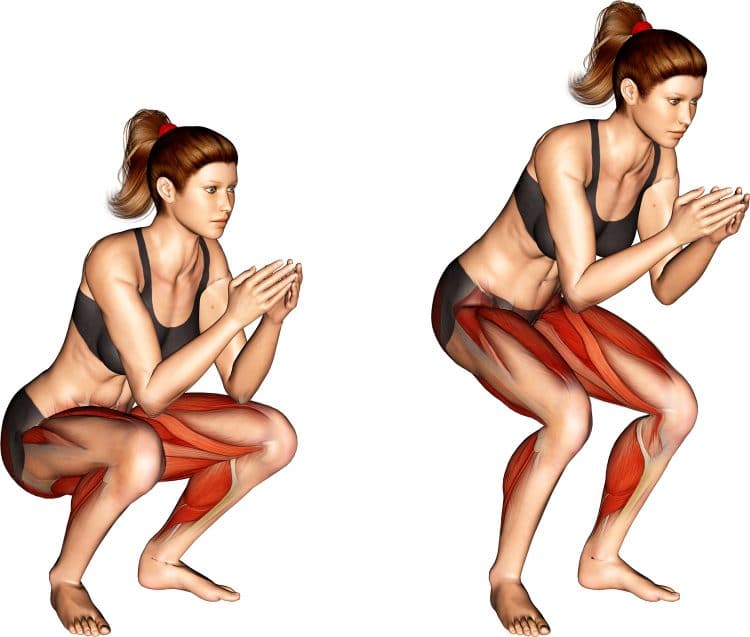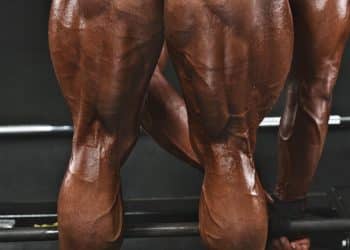The frog squat is one of the more interesting exercise variations and it doesn’t involve leaping or jumping like a frog contrary to what you might have thought.
It requires a little more technique than the simplest of exercises but well worth the effort. Plus, once you get it down pat there’s nothing to it. This exercise can build the lower body muscles and you don’t need weights which means you have a convenient lower body exercise that you can perform anywhere.
The frog squat is great not only for improving muscularity but it can help to improve posture, reduce stiffness, and is a great option for mixing up your training.
In this guide, we’ve explained muscles worked, how to do it with tips, and variations.
Muscles Worked in Frog Squat
Quadriceps
Frog squats are one way to activate your quad muscles through a deep squat and explosive jump. The quads were previously thought to have four heads, however, there are actually five as discovered in recent years. The quads are going to contribute a lot of strength to your lower body movements that involve hip flexion and knee extension.
Level Up Your Fitness: Join our 💪 strong community in Fitness Volt Newsletter. Get daily inspiration, expert-backed workouts, nutrition tips, the latest in strength sports, and the support you need to reach your goals. Subscribe for free!
Hamstrings
Don’t forget about the hamstring muscles even though we hardly ever see them. Hamstrings are three muscles combined on the posterior thigh that complete the opposing action to your quads which is to extend the thigh and flex the knee joint.
Glutes
Most people would never know that the largest butt muscles – gluteus maximus – is also the largest muscle in the human body. The glutes are a powerful trio of muscles also including the gluteus medius and minimus. Its action is found on the hip joint that is adduction (pulling the thigh inward) and extension of the thigh. Let’s just say the quads are important for all physical activities.
Core
The core benefits from every squat activity, making your trunk stronger to support heavier weights and more intense activities. The deep muscles of the midsection can brace to allow us the support we need to maintain proper lifting posture and promote optimal performance.
How To Do The Frog Squat
Here are step-by-step instructions for performing the frog squat.
- Use a wider than shoulder-width squat stance that’s comfortable for you and point your toes slightly outward.
- Squat down, place your arms on the insides of your thighs, ideally on your knees, and place your hands together in front of you.
- While keeping your back straight and core tight, lean forward from the hips but stop short of full leg extension so there’s still bend in your knees.
- Come back down and repeat.
Here’s a video example…
Frog squat tips
- Make sure to keep your back straight during the exercise because it can be tempting to want to round it.
- Keep your core tight and your hips, knees, and ankles soft during the movement.
- Avoid allowing your knees to pass your toes.
- Avoid fully extending your legs.
Frog Squat Variations / Alternatives
The frog squat is a neat exercise that offers great benefits. But if you can’t do it or prefer using other exercises to accomplish the same thing, consider these variations/alternatives.
Related: The 12 Best Squat Variations for Hypertrophy and Strength
1. Basic bodyweight squat
If for whatever reason you choose not to try out the frog squat, you can never go wrong with the basic bodyweight squat/ sumo squat to train the same muscle groups.
Level Up Your Fitness: Join our 💪 strong community in Fitness Volt Newsletter. Get daily inspiration, expert-backed workouts, nutrition tips, the latest in strength sports, and the support you need to reach your goals. Subscribe for free!
The starting position is similar but then rather than leaning forward, you’ll stand straight up.
2. Machine frog squat
If you’re more advanced and really want to try a variation that packs on the size and strength, then we recommend the machine frog squat.
While you won’t be able to lean forward and back like the bodyweight version, maintaining a forward lean position similar to the video example below can have a similar effect.
3. Goblet squat
The goblet squat is a popular exercise because a weight is held at chest level while the exerciser performs squats. You’ll not only build impressive legs but you’re core and posture will greatly benefit.
Here’s a full guide to the goblet squat.
How To Incorporate The Frog Squat Into Your Training Routine
While the frog squat is worth including in your training regime, we don’t recommend making it the only leg exercise you do. You should still do conventional weighted squats (front and back squats or both), deadlifts, leg press, etc simply because these exercises build the most muscle and strength.
So do frog squats alongside the aforementioned exercises whether as a warmup or finishing exercise.
However, some days you may not have weights or feel up to doing these exercises and frog squats can be a suitable option for these instances.
Try These Three Killer Leg Workouts for Muscle Growth.
Sets/reps
To make it worthwhile, 2-4 sets of anywhere from 10-20+ reps should be sufficient to benefit from frog squats. But this is simply a recommendation and you can adjust the sets/ reps according to your experience level and goals.
Wrapping Up
The frog squat is a unique exercise that can be an effective tool in your lower body and functional training arsenal. The movement replicates normal human position and movement but it can help to improve posture and stiffness.
There are also several great variations and alternatives that can be similarly beneficial, although there are certainly advantages to the frog squat.
Interested in measuring your progress? Check out our strength standards for Bodyweight Squat, Goblet Squat, Deadlift, and more.









